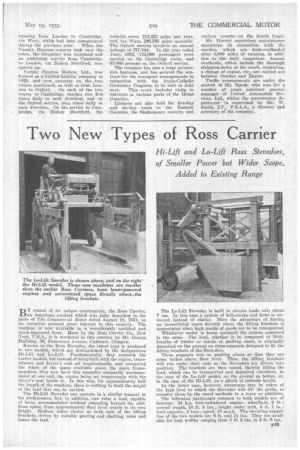Two New Types of Ross Carrier
Page 57

If you've noticed an error in this article please click here to report it so we can fix it.
Hi-Lift and Lo-Lift Ross Stevedors, of Smaller Power but Wider Scope, Added to Existing Range
Breason of its unique construction, the Ross Carrier, an Americanproduct which was fully described in the issue of Tire Commercial Motor dated August 18, 1931, on its inception aroused great interest in this country. The rev:Chine is now eeailable in a considerably modified and much-improved form. Made by the Ross Carrier Co., New lode U.S.A., it is marketed in this country by Mr. George Helliday, 56, Deanwood Avenue, Cathcart, Glasgow; Known as the Roes Stevedor, the latest type is produced in two models, which are distinguished by the designations Hi-Lift and Lo-Lift. Fundamentally, they resemble the earlier models, but instead of bele g,built with the engine, transmission and driver's seat set longitudinally, and occupying the whole of the space available above the main framemembere, they now have this assembly compactly accommodated at one end, the engine being set transversely with the driver's seat beside it. In this way, for approximately half the length of the machine, there is nothing to limit the height of the load that can be carried.
The Hi-Lift Stevedor can operate in a similar manner to ite eredeeessors, hut, in addition, can raise a load, capable of being accommodated without extending beyond the platform space, from approximately floor level nearly to its own height. Endless roller chains at both ends of the lifting brackets, driven by suitable gearing. and shafting, raise and lower the load.
The Lo-Lift Stevedor is built to elevate loads only about 7 ins. In this case a system of bell-cranks and links is employed .instead of chains. Here the advantage of having an unrestricted space directly above the lifting brackets is appreciated when high stacks of goods are to be transported. Whichever model is being operated the system practised is the same. The load, whether it be composed of 50-ft. lengths of timber or stacks of packing cases, is originally deposited on the ground on cross-supports designed to fit the lifting brackets of the Stevedore.
These supports rest on packing pieces so that they aresome inches above floor level. Thus, the lifting brackets will run under their ends as the Steveders arc driven into position. The brackets are then raised, thereby lifting the load, which can he transported and deposited elsewhere, in the case of the Lo-Lift metlel, on the ground as before, or, in the ease of the Hi-Lift, on a plinth of suitable height.
In the latter ease, however, advantage may be taken of the high level to which the Stevedor will lift the goods, to transfer them by the usual methods to a lorry or platform.
The following particulars common to both models are of• interest: 24 h.p. four-cylindered engine: wheelbase, 6 ft.-; overall length, 10 ft. 8 ins.; height under arch, 4 ft. 1 in.; load capacity, 3 tons; speed, 18 m.p.h. The elevating capacities of the two models are 6 ft. and 7e ins. They are available for load widths ranging from 3 ft. 2 ins. to 4 ft. 8 ins.




























































































